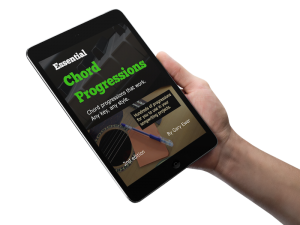Take a look at the chords in pop music today, and you don’t see the diminished chord being used much. It’s an extremely versatile chord, but it’s possible that songwriters might be a bit confused as to how to use it.
And by “use it”, I think many just don’t know how to approach the chord in a sequence, and then how to leave it.
 Just need some chords to get your songwriting process started? “Essential Chord Progressions” and “More Essential Chord Progressions” will do the trick. Get them separately, or as part of “The Essential Secrets of Songwriting 10-eBook Bundle.
Just need some chords to get your songwriting process started? “Essential Chord Progressions” and “More Essential Chord Progressions” will do the trick. Get them separately, or as part of “The Essential Secrets of Songwriting 10-eBook Bundle.
A Bit of the Theory…
A diminished seventh chord is comprised of a diminished triad, with a fourth note the interval of a diminished seventh on the top. You get a diminished triad when you stack minor 3rds, so B diminished — a chord that occurs naturally in C major — would consist of the notes B-D-F. Adding a diminished seventh — Ab — would give us Bdim7:
B-D-F-Ab
That chord moves nicely toward a C chord:
Bdim7 C
In that case, the note B is acting like a leading tone toward the tonic note.
But because the chord consists entirely of stacked minor 3rds, any one of those notes can act like a leading tone, and that gives the dim7 chord a special versatility.
So instead of calling it Bdim7 and having it move to C, you could think of the D as the leading tone, call it Ddim7, and allow it to move to Eb or Ebm:
Ddim7 Eb (or Ebm)
Or Fdim7, which moves to Gb or Gbm, or Abdim7 which moves to A or Am.
In common usage, songwriters don’t even usually concern themselves by making sure they’re using the leading tone at the bottom of the chord as the letter name. So you might call them all Bdim7, regardless of where they eventually go.
How to Use the Diminished Seventh
So because this chord can move so easily to so many different chords, it’s a great way to change key (either permanently or temporarily), and/or to add delicious and unexpected colours to your chord palette, in a passing chord situation.
First, let’s look at passing chords. A passing chord is simply a chord that gets inserted between two important structural chords within your progression, with the bass note filling in the gap between those chords. If you play C moving to Am, you can insert G/B (a G chord with a B in the bass) as a nice passing chord, the bass creating a C-B-A line.
It turns out that the dim7 chord performs this passing role quite nicely. Some examples:
C C#dim7 Dm G C
C F F#dim7 G Am
C Ebdim7 Em A7 D7 G C
To create these progressions, I did the following:
- I thought up a simple C major progression. (ex: C Dm G C)
- I chose a spot, somewhat randomly, to insert a diminished seventh chord (ex: after the first C).
- I looked at the chord after where I’m planning to insert the dim7. (ex: Dm)
- I created a dim7 built on the note a semitone below that note. (Ex: C#)
If the chord following the dim7 is from the key of your song, you’ve simply created a nice altered chord that adds colour to your progression. A good example: George Harrison’s “All Those Years Ago“: D Em Edim7 D
But you can use the chord to change key, by allowing the chord after the dim7 to be a new tonic, like this:
C F G G#dim7 |Am Dm Esus4 E |Am…
It’s a great chord to experiment with. Every time you play a dim7 in your progression, you can think of any of the four notes of that chord as being a leading tone to a new tonic, and you’ve got an easy and smooth way to change key.
In that regard, you may want to think of the dim7 chord as one to try at the end of your second chorus, to get you to a bridge section that starts in a new key.


Written by Gary Ewer. Follow Gary on Twitter
Thousands of songwriters are using The Essential Secrets of Songwriting eBooks to straighten out their songwriting problems. Have you been spending years just reinforcing errors? Sort out your technique! Get today’s free deal!











Hooray! At last a clear explanation of how these chords can be resolved and used. Has taken ages to find this.
You are the first one to let me know where the diminished 7 chords can be inserted.
Thank you! Keep up the good worked.